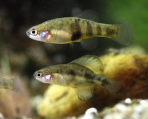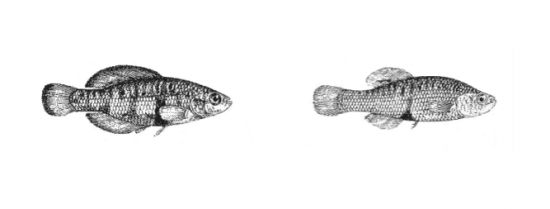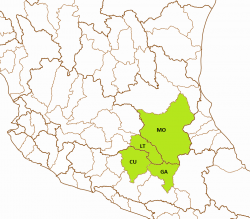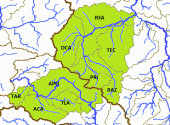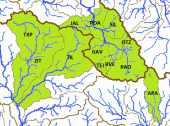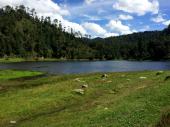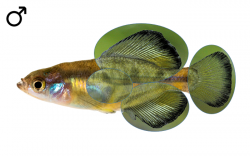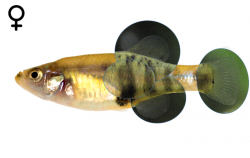- HOME
- ABOUT US
- ABOUT GOODEIDS
- GOODEID SPECIES
- PLAN G
- ABOUT PROFUNDULIDS (in development)
- PROFUNDULID SPECIES (in development)
- LINKS
- DONATIONS
Girardinichthys multiradiatus
English Name:
Darkedged Splitfin
Mexican Name:
Mexclapique (erronously: Mexcalpique) de Zempoala
Original Description:
MEEK, S. E. (1904): The fresh-water fishes of Mexico north of the Isthmus of Tehuantepec. Publication. Field Columbian Museum 93, Zoological Series 5: pp 1-252
Holotype:
Collection-number: Field Columbian Museum, Cat. No. FMNH-4523.
The Holotype has got a total length of 39.6mm and was collected by Joseph Nelson Rose between 1896 and 1901. Evermann and Goldsborough mentioned that Rose found this species to be abundant in the Río Lerma, but how many individuals had been collected needs to be investigated as the specimen cataloged in the Field Museum under the number of the Holotype is erronously awarded S. E. Meek with collection date March 17th, 1903. For explanation: Meek refered to the fact, that the fish he used for description in 1904 came originally from this Rose collection. Charles Tate Regan (1907) mentioned four specimens he got to describe, probably from the material Meek had at hand. The drawings he published show individuals of both sexes.
Regans drawings of Girardinichthys multiradiatus; male left, female right:
Terra typica:
Etymology:
This species name is derived from the Latin. The word "multi" means "many" and "radiatus" is derived from the latin noun "radium" meaning ray, therefore "radiatus" can be translated with "with rays",. The specific epithet means "with many rays" and refers to the higher number of rays in the dorsal and anal fin.
Pieter Bleeker erected this genus 1860 to honour the French biologist Charles Frédéric Girard. As Bleeker did many of his publications in Latin, he latinized Girard into Girardinus, and with the second part of the name, ἰχθύς (íchthús, íchthýs), the Greek word for fish, the generic name can be translated with "Girards fish".
Synonyms:
Girardinichthys innominatus Evermann & Goldsborough, 1902 (misidentification)
Characodon multiradiatus Meek, 1904
Lermichthys multiradiatus Hubbs, 1926
Girardinichthys limnurgus Jordan & Evermann, 1927
Distribution and ESU's:
The Darkedged Splitfin is endemic mainly to the Mexican federal states of Mexico and Michoacán, but reaching on the fringe of its distribution also the federal states of Querétaro, Morelos and even Hidalgo. The centre of its historical distribution is the upper Río Lerma drainage, where it occured mainly in channels, dams, creeks, ponds and lakes along the river. The habitats closest to the Lerma river sources are the Laguna Chignahuapán and swamps near Xalatlaco S of Toluca de Lerdo. The distribution includes also habitats along some of upper Lerma main affluents like the ríos Las Minas and Cachiví and the Arroyo Jaltepec. The westernmost habitat along the Río Lerma is the San Miguel spring in Maravatío de Ocampo, only 45km E of the Laguna Cuitzeo but about 150km NW (both distances beeline) from the Río Lerma sources. Additionally to the Río Lerma drainage, Girardinichthys multiradiatus managed on several points to occupy two more big drainages. One is in the S the Río Balsas drainage with the Arroyo El Zarco in the headwaters of the Río Turundeo W of Ciudad Hidalgo (the westernmost known habitat in general), 30km SW of Maravatio de Ocampo, the endorheic Presa El Bosque S of the town of Heroica Zitácuaro and dams within the headwaters of the Río Tiloxtoc, all these localities within the Río Cutzmala basin. The eastern- and southernmost known habitats in general about 25km SW of Mexico City are the endorheic Lagunas Zempoalas within the Río Amacuzac basin, also Río Balsas drainage, the only known habitats within the state of Morelos. The third big drainage where this species occurs is the Río Pánuco drainage in the N of the Río Lerma. The distribution encompasses several smaller dams in the headwaters of the Arroyo Characol SW of San Juan del Río (e.g. La Goleta and San Martins dam) in the state of Querétaro, the Presa Huapango and smaller dams near Polotitlán de la Illustración, Río San Juan headwaters in the state of Mexico and the only known habitat in the state of Hidalgo, a small dam about 6km NE of Polotitlán, draining into the Arroyo Casas Viejas, a Río San Francisco affluent. Mercado-Silva confirmed its presence in the Tonatiahua and Zempoala lakes in Morelos through suveys in 2016 and 2017 and the habitats in the Río Balsas and Pánuco drainages are partly still populated with this species (Lyons, 2011; Domínguez-Domínguez, 2005). The distribution and abundance declined substantially over the 20th century (Lyons, 2011), leaving remnant stocks. A new stock has been discovered on a survey of the GWG W of Ciudad Hidalgo (2017). According to its appearance in four different drainages, four subpopulations can be distinguished: The Río Lerma subpopulation (type subpopulation), the Río Pánuco subpopulation, the Río Cutzmala subpopulation and the Lagunas de Zempoala subpopulation. The underlined names are the ones officially used by the Instituto Nacional de Estadística y Geografía; nevertheless, other ones might be more often in use or better known and therefore prefered.
ESU ist short for Evolutionarily Significant Unit. Each unit expresses an isolated population with different genetic characteristics within one species. ESU's can be defined by Molecular genetics, Morphology and/or Zoogeography and help in indicating different phylogenetic lineages within a species. The abbreviation for an ESU is composed of the first 3 letters of the genus, followed by the first 2 letters of the species name and an ongoing number in each species.
Actually, we distinguish two ESU`s in Girardinichthys multiradiatus. Girmu1 for the population in the Lagunas de Zempoala and Girmu2 for all the other ones, including the ríos Lerma, Pánuco and Balsas.
The left map shows the Río Moctezuma (MO) basin from the Hydrographic Region Pánuco, the ríos Grande de Amacuzac (GA) and Cutzamala (CU) basins from the Hydrographic Region Balsas and the Río Lerma-Toluca (LT) basin from the Hydrographic Region Lerma-Santiago on a Mexico map. The distribution of the Darkedged Splitfin in the northern habitats is shown on the middle map. Within the Río Moctezuma basin, it occurs along the Río San Juán and the populated subbasins are the ríos Prieto (PRI), Arroyo Zarco (RAZ), Tecozutla (TEC) and San Juán (RSA) subbasins, and the Drenaje Caracol subbasin (DCA). The middle map shows additionally the four northernmost subbasins populated with this species within the Río Lerma-Toluca basin, namely the ríos Atlacomulco-Paso de Ovejas (APO) and Tlalpujahua (TLA) subbasins, and the arroyos Cavichi (ACA) and Tarandacuao (TAR) subbasins. The right map shows the subbasins within the Hydrographic Region Balsas. These are in the Río Grande de Amacuzac basin the Río Apatlaco (APA) subbasin - the only area where the ESU Girmu1 can be found (Zempoala lakes) -, and in the Río Cutzamala basin the ríos Tilostoc (TIL), Zitácuaro (ZIT) and Tuxpan (TXP) subbasins. More subbasins within the Río Lerma-Toluca basin and shown on this map are the ríos Otzolotepec-Río Atlacomulco (ROA), Sila (SIL), Jaltepec (JAL), Almoloya-Otzolotepec (RAO), Gavia (GAV), Otzolotepec (OTZ), Verdiguel (RVE) and Tejalpa (TEJ) subbasins. All of these waterbodies except for the Zempoala lakes are populated with specimens from the ESU Girmu2:
Status :
International Union for Conservation of Nature (IUCN): Endangered
Distribution and current conservation status of the Mexican Goodeidae (Lyons et al., 2019): Endangered/declining: „This species was known historically from approximately 16 locations located just northwest, west, and south of greater Mexico City, including 13 streams and wetlands in the upper Lerma River basin and single sites in the headwaters of the Balsas River basin on the Pacific slope, the endorheic Lake Zempoala system, and the Taxingu Reservoir in the upper Pánuco River basin on the Atlantic slope (Domínguez-Domínguez et al., 2005). Distribution and abundance of G. multiradiatus declined substantially in the Lerma basin during the 20th Century, and the seven remaining populations there are now low in numbers and isolated, with some in decline and approaching extirpation. The Balsas, Zempoala, and Taxingu populations still persist but are small. Little clear genetic divergence is evident among populations from the Lerma, Balsas, and Pánuco basins (Macias-García et al., 2012). We used zoogeography to identify two ESUs. Girmu1 is limited to Lake Zempoala, which has been long isolated from the upper Lerma and Balsas basins and which experiences colder conditions than other goodeid habitats in Mexico. This ESU is endangered, with a moderate population in the small lake, which is fortunately protected as a National Park. Girmu2 encompasses all other populations and is also endangered.“
NOM-059-SEMARNAT-2010: no categoría de riesgo (no category of risk)
Habitat:
The Darkedged Splitfin lives in quiet to sligthly moving waters of small lakes, spring-fed ponds and ditches and near banks of pools of cool streams. It can be found over substrates of silt, mud, clay, sand, gravel and rocks. Like all known Goodeids, it prefers clear to muddy water and depths of less than 1m, frequently 0.6m or less. The vegetation comprises green algae, Lemna, Salvinia, Nasturtium, Potamogeton, Scirpus and Juncus.
On a survey of the GWG to the endorheic Río Grande de Morelia basin and adjacent areas (2017), the species was discovered in a creek and channel near Ciudad Hidalgo, Río Balsas drainage. The species occured mainly in a murky bay with little current, partly shaded by riparian grass. Other species cooccuring were the native Goodea atripinnis and the exotics Poecilia mexicana and Xiphophorus hellerii. The spring fed pond in Maravatio had good stocks of the Darkedged Splitfin a couple of years ago, but in 2014, the sudden occurence of Guppys and already before of Pseudoxiphophorus bimaculatus reduced the population to a remnant stock with uncertain prospects for the future.
Biology:
A paper from Cruz-Gómez et al. (2013) revealed a breeding season from May to September. The scientists bimonthly sampled fish in the Huapango reservoir (State of México), finding the highest values of the gonadosomatic index, the calculation of the gonad mass as a proportion of the total body mass, in this period. However, reproduction occurs also in most of the other months except in the coldest ones, means November to February. Therefore, the spawning period seems to start about March with the increase of temperature. A study at San Martin dam from Garcia-Trejo et al. (2013) ascertained some water parameters like oxygen content, water temperature, pH and conductivity in this reservoir in Querétaro. They found very soft water and a stable behavior of the physicochemical water parameters during the hydrological cycle from February to December with a pH between 7 and 9 and a dissolved oxygen level between 7 and 10ppm. By contrast, the water temperature showed significant variation with the highest temperatures (20-25°C) recorded between April and August and the lowest (10-18°C) between October and February.
Diet:
Meek described incisor-like bicuspid teeth, but made no statements concerning the length of its gut, which is a good indicator of if the fish is carnivorious, omnivorous or herbivorous. In contrary to its congener Girardinichthys viviparus, the mouth is bigger and the cleft not vertical, so we might have here - taking all known facts in consideration - a more omnivorous species than the Mexcalpique. Studies of Garcia-Trejo et al. (2013) at San Martins Dam, Querétaro, and Trujillo & Viveros (2006) in the Zempoala lagoons in the state of Morelos reveleaed that Girardinichthys multiradiatus is a polytrophic, but mainly carnivorous species. The stomach contents of the study in 2006 were composed of chironomid-larvae, mayflies and Hymenoptera, whereas the analysis done in the lagoon at San Martins dam showed 47% of Diptera-larvae and 24% of Detritus. Together with 17% Cladocera, these three matters made up nearly 90% of the stomach content. Juvenile fish displayed a slightly higher percentage of Cladocera and Diptera in this study, but less Detritus.
Size:
The maximum known standard length is 55mm (Miller et al., 2005).
Colouration:
Both sexes are coloured greyish-yellow to bright yellow. Typically, females have a gravity spot, which males are lacking. The upper half of the body is darker, the venter can be coloured cream-yellow to yellow. Males show dark pigmented unpaired fins, some almost black. On its base, they show small or bigger sized yellowish to golden areas. In some populations, the fins appear brightly yellow to orange or golden coloured with dark edges. Both sexes show several bars on the upper half of their sides, with the origin behind the opercle, reaching the caudal base and becoming more prominant posteriorly, but these bars are indistinct in males. In some females, these bars fade and the fish appear totally yellow or golden. The paired fins and the unpaired fins in females are clear.
Sexual Dimorphism:
Males and females of the Darkedged Splitfin are easy to distinguish. A safe characteristic is the Splitfin in males, means the for Goodeinae typical mating organ formed by a notch after the first seven shortened rays of the Anal fin, in the case of Girardinichthys multiradiatus also much longer (with more fin rays) and bigger than the Anal fin of females. Additionally, males have also a much bigger and longer Dorsal fin than females. The difference in colouration is clear and distinct. Males have the unpaired fins coloured yellow or yellowish with more or less broad black terminal bands while females have clear fins. Females again have a distinct big gravity spot in contrast to males and have the posterior part of the body broad striped while males display only a faint stripe pattern.
Remarks:
Meek discovered, that specimens identified as Girardinichthys innominatus (a synonym of viviparus) from the Río Lerma drainage belong to a distinct species and described it in 1904 as Characodon multiradiatus. He pointed out the fact, that this species resembles Girardinichthys innominatus, with which it has been previously mistaken, nevertheless, he placed it in Characodon. Even Hubbs and Turner (1939) brought up, that Lermichthys multiradiatus - the new genus it was placed in by Hubbs (1926) - "is a close relative of Girardinichthys, and probably a derivative." Finally, Miller and Fitzsimmons (1971) synonymized Lermichthys with Girardinichthys. The genus Lermichthys is one of only five that have been erected exclusively for Goodeid fish and lateron became synonyms. In case of Lermichthys, its only representative, the Darkedged Splitfin was decades later correctly recognized as member of the genus Girardinichthys. The etymology of the genus can be derived from the Río Lerma, the river, the types of the Darkedged Splitfin came from, and ἰχθύς (íchthús, íchthýs), the Greek word for fish, so the generic name can be translated with "fish from the Lerma (river)". The name Lerma itself in this context goes back to honouring Francisco Gómez de Sandoval y Rojas, the 1st Duke of Lerma, a town in the Spanish Province Burgos.
The Darkedged Splifin possesses a few records among Goodeids: It occurs in waters with the widest range of parametres we can find among Goodeids. This range goes from soft to hard and from acidic (pH 6.0) to alkaline (pH 9.0). Additionally, this species is a real mountain climber: It inhabits the endorheic Zempoala lagoons in the federal state of Morelos and these lagoons are situated about 2.800m above sea level. These lagoons are the highest known habitats we know populated with Goodeids.
Macías-Garcia and Burt de Perera (2002) published a very interesting study, that revealed that Girardinichthys multiradiatus, at least females, are capable of seeing UV light. Male fish show UV reflecting markings on their sides that play an important role in courtship. As the most important predator of the Darkedged Splitfin, Tamnophis melanogaster, a Garter snake, is likewise able to see this part of the light spectrum, this might be the reason for a sex ratio favoring females in the wild.
Husbandry:
Looking on the biotopes of Girardinichthys multiradiatus, they suggest the species may prefer a habitat with none to moderate current, structured with gravel, rocks, roots, branches, fallen leaves and submerse or/and river bank vegetation. Fry is usually not eaten, but it may depend on the quantity and quality of food and on the number of places to hide, so it is easy to get a flock breeding colony.
The recommended tank size is at least 80 liters, bigger tanks with a generous base and little height (25cm are enough) are better for sure. With few rocks or roots and dense vegetation in the corners and backside of the tank well structured tanks combined with some roots and/or wood seem to do best with this species. The current should be moderate, specially as the species is adapted to a high oxygene level (at least 8mg/l).
In the wild, the species feeds mainly from small invertebrates like Copepods or insect larvae, so feeding with similar food like water fleas and other food from animalistic sources will be best for this predominantly predatory fish. In aquarium, it feeds also well from flake food, granulate and even tablets, additionally given Nauplia of Brine Shrimps are eaten greedy. The species is not really shy, but likes to use hiding spots to observe the surrounding.
Concerning water quality, this species is in need of bigger water changes (60-80% every week) like most of the Goodeids, especially river and spring inhabiting species, so an automatic water changing system can be helpful. Otherwise, in combination with constant temperatures higher than 22°C, fish may get sick, lose resistance against diseases and age too fast. So for keeping the strain healthy and strong, give the fish a rest during winter time with temperatures lower than 18°C for 2 or 3 months so they stop producing fry. This species can be kept down to temperatures of 10°C without problems for weeks. In spring, when the temperature slowly increases, they will start spawning at 17 or 18°C and won't stop until it gets colder again or when it gets too warm (24°C).
This species is doing very well when is kept in the open from spring to fall, starting when the water temperature by day exceeds 12°C and cold periods are no longer expected. Bring them out in the early afternoon, the time of the day with the highest water temperature. During the warm summer, reproduction will stop and may occur again in fall. Bring the fish in before the water temperature deceeds 12°C by day and keep them cool for the first days, then slowly raise the temperature but try to stay below 18°C over the winter time.


















